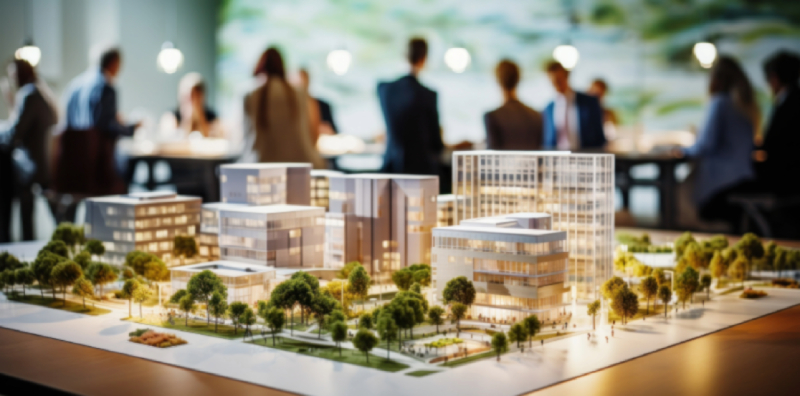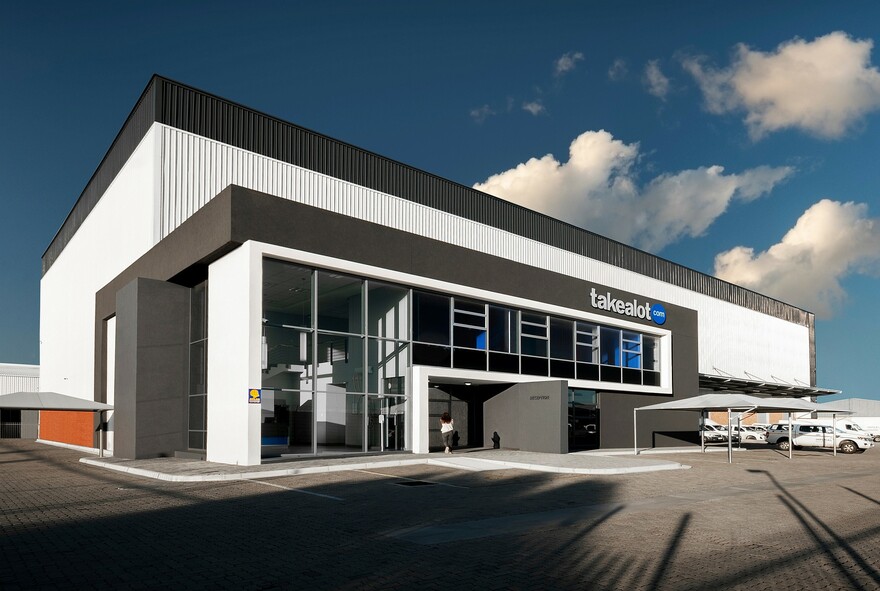Unveiling the Comprehensive Providers Given by Commercial Architects for Modern Advancement
Commercial Architects offer a crucial feature in contemporary development tasks. They blend design appearances with functionality while sticking to regulatory requirements. Their experience prolongs past plain building, integrating sustainable practices and ingenious innovations. As they browse complex zoning legislations, Architects work together with numerous stakeholders to bring visions to life. This diverse technique elevates concerns concerning the advancing duty of Architects in forming modern areas and the impact of their deal with future growths.
Comprehending the Duty of Commercial Architects in Modern Advancement
In modern city landscapes, Commercial Architects play a crucial role in shaping useful and aesthetic spaces that fulfill diverse organization requirements. Their knowledge prolongs past plain design; they navigate intricate zoning regulations, constructing codes, and environmental laws. By collaborating with customers, they determine details requirements, guaranteeing that each project lines up with the customer's vision while likewise considering practical aspects such as sustainability and cost-effectiveness. Commercial Architects are skilled at integrating cutting-edge innovations and products into their styles, enhancing both the functionality and power effectiveness of structures. They perform detailed website analyses to evaluate the potential difficulties and chances presented by a place. In addition, effective communication with contractors and other stakeholders is necessary, making sure that the task progresses smoothly from perception to completion. Inevitably, Commercial Architects contribute in producing rooms that not just satisfy functional functions but likewise add to the overall character and vibrancy of metropolitan environments.
Idea Style: Changing Concepts Into Reality
Idea layout functions as a necessary phase in Commercial design, where ingenious layout services emerge from imaginative brainstorming. This procedure counts on collaborative ideation, combining varied viewpoints to fine-tune and enhance initial ideas. As ideas form, they change from abstract notions right into tangible architectural realities.
Innovative Layout Solutions
Changing concepts into truth is the characteristic of innovative style solutions in Commercial design. These services mix creative thinking with capability, resolving the distinct needs of contemporary advancements. By leveraging advanced modern technologies and lasting practices, Architects craft spaces that are not just aesthetically attractive but likewise reliable and adaptable. Emphasis on individual experience drives the layout process, making certain that atmospheres foster productivity and cooperation. Each project advantages from a tailored technique, where concepts are meticulously developed to mirror the client's vision while thinking about future fads. Cutting-edge layout options likewise focus on adaptability, enabling modifications over time as business demands evolve. Inevitably, these methods improve the general worth of Commercial rooms, making them pivotal in today's affordable landscape.

Collective Ideation Process
Collaboration works as the backbone of the ideation process in Commercial design, fostering imagination and technology amongst varied stakeholders. Architects, customers, engineers, and neighborhood members involve in vibrant conversations, making sure that all viewpoints are considered. This comprehensive method enables the exploration of numerous layout ideas, encouraging unique services that line up with the project's vision. Via workshops and brainstorming sessions, ideas progress and fine-tune, transforming preliminary ideas into substantial designs. Innovation also plays a crucial role, with tools such as Building Information Modeling (BIM) promoting real-time partnership and modifications. Inevitably, this joint ideation process not only boosts the design result however likewise grows a feeling of possession and investment amongst all events involved, leading to successful Commercial advancements.
Zoning Analysis: Navigating Regulations and Conformity
As designers begin on brand-new jobs, understanding zoning laws is necessary to making certain compliance and staying clear of expensive delays. Zoning evaluation plays an essential function in this procedure, as it includes reviewing regional zoning regulations that determine land use, constructing height, thickness, and obstacles. Commercial Architects have the proficiency to navigate these intricate regulations, assisting customers recognize permitted usages and any type of essential variances.
Sustainable Style Practices: Building for the Future
Lasting style techniques are increasingly vital in the domain name of Commercial architecture, especially as environmental worries proceed to rise. Architects prioritize green products, energy-efficient systems, and layout approaches that reduce waste and ecological impact. Incorporating renewable resource resources, such as solar panels and wind turbines, allows structures to generate their very own power and decrease dependence on fossil fuels.Furthermore, sustainable design highlights the relevance of interior ecological quality. This consists of using all-natural light, improving air flow, and choosing non-toxic products to improve passenger health and efficiency. Environment-friendly roof coverings and living walls are also preferred features that add to biodiversity and urban cooling.Additionally, Commercial Architects often incorporate water conservation techniques, like rainwater harvesting and drought-resistant landscape design. Via these cutting-edge strategies, they develop areas that not just fulfill contemporary requirements however also foster a lasting future, resolving the expanding need for responsible growth in the modern-day world.
Task Monitoring: Ensuring Timely and Reliable Execution
Efficient project monitoring is vital for making sure that Commercial architecture tasks are completed on time and within budget. This function includes a range of obligations, consisting of the coordination of various stakeholders, timelines, and resources. Commercial Architects utilize their know-how to produce in-depth task plans that describe vital turning points and deliverables, permitting organized development tracking.Regular interaction amongst team participants and clients is critical, cultivating openness and promoting punctual decision-making. Threat administration techniques are likewise used to determine potential obstacles early, enabling positive options to be created. By utilizing sophisticated task management tools, Architects can monitor task performance in real-time, making changes as required to keep efficiency.
Interior Design: Producing Useful and Visual Rooms
Inside design plays a crucial duty in boosting both capability and aesthetics within Commercial areas. Efficient room planning can maximize process and improve user experience, while aesthetic style principles contribute to a visually appealing environment - commercial architects. With he said each other, these elements develop areas that are not just practical but also inspiring
Space Preparation Efficiency
While making best use of the energy of readily available area, Commercial Architects prioritize area preparation effectiveness to produce both useful and visually pleasing settings. This technique includes careful evaluation of the spatial format to more assure perfect use every square foot. Architects think about variables such as workflow, availability, and all-natural light to enhance functionality. By purposefully positioning furnishings, tools, and workstations, they help with movement and communication amongst users, advertising efficiency. Additionally, zoning various areas for specific features helps in taking care of sound and privacy, creating an unified ambience. Via efficient space preparation, Commercial Architects can transform restraints into possibilities, guaranteeing that each area fulfills the diverse needs of its passengers while adhering to governing demands and industry requirements.
Visual Style Principles
Aesthetic layout principles play a necessary role fit settings that are not just functional yet additionally visually enticing. These concepts assist Commercial Architects in producing rooms that reverberate with users while improving brand identification. Key elements consist of equilibrium, percentage, and consistency, which collaborate to create a natural look. Color design and materials are meticulously selected to evoke preferred emotions and sustain the total theme. In addition, illumination plays a critical function, influencing state of mind and exposure while highlighting building attributes. By incorporating these concepts, Architects guarantee that spaces are not just functional but additionally inviting and inspiring. Eventually, reliable visual design fosters a positive user experience, motivating check my source involvement and complete satisfaction in Commercial environments.
Collaboration With Stakeholders: Promoting Successful Collaborations
Successful partnerships in Commercial design joint on reliable cooperation with stakeholders, ensuring that every voice is heard and valued. This joint method includes engaging various parties, consisting of customers, contractors, and community members, throughout the style and advancement process. By fostering open communication, Commercial Architects can resolve problems, gather insights, and straighten the project's vision with stakeholder expectations.The assimilation of diverse perspectives enhances creativity and advancement, resulting in more functional and aesthetically pleasing styles. Routine meetings, feedback sessions, and workshops facilitate this dialogue, permitting Architects to adapt their strategies in reaction to stakeholder input. Additionally, developing count on through openness and accountability strengthens these partnerships, resulting in a smoother project execution.Ultimately, the success of modern advancements depends on the Architects' capability to navigate and integrate differing interests, creating a collaborative setting that advertises common goals and shared success.
Frequently Asked Concerns
Exactly How Do Commercial Architects Deal With Budget Constraints Throughout a Job?

What Kinds of Software Do Commercial Architects Commonly Make Use Of?
Commercial Architects generally utilize software application such as AutoCAD for preparing, Revit for Building Information Modeling, SketchUp for 3D modeling, and task monitoring devices like Microsoft Job to boost collaboration and streamline operations throughout the design procedure.
Can Commercial Architects Help With Obtaining Funding for Projects?
Commercial Architects can help in getting funding for projects by preparing in-depth propositions, helping to articulate layout visions, and supplying monetary projections that can boost the probability of safeguarding required financing from capitalists or banks.
Exactly How Do Architects Guarantee Safety Throughout the Building Refine?
Architects ensure security throughout building by executing strenuous style criteria, collaborating with engineers, conducting routine website assessments, adhering to neighborhood guidelines, and fostering communication amongst all stakeholders to reduce dangers and advertise a secure workplace.
What Continuous Support Do Architects Provide After Job Conclusion?
After task completion, Architects provide continuous assistance via maintenance consultations, performance analyses, and design alterations. They assure structures fulfill progressing demands, address prospective concerns, and maintain compliance with guidelines, cultivating a long-term connection with clients.